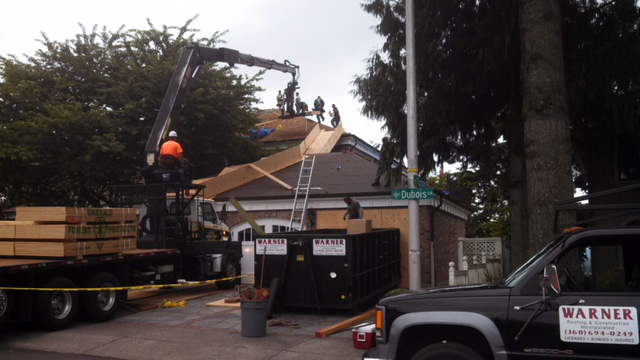
Published on November 18, 2019
There are roofing materials that will last 50, 60, even 100 years or more with proper maintenance. However, if your home was built before the turn of the century, many of these options weren’t around. And if they were, the average cost might have priced out the general public.
As newer technologies and materials become more commonplace, the cost for materials and installation reflects that. As more advanced roofing materials become mass-produced, what you can expect to pay will decrease over time. However, there are still factors that will always have an effect on how much a new roofing project will cost.
Roof Size, Shape, and Slope
It doesn’t matter if you’re putting in standard 3-tab shingles or top of the line slate shingles. Roof installation will always cost less for a two-bedroom bungalow than a 3,000 square foot home. Even homes with roughly the same square footage can be priced quite differently.
A lot more planning and care go into a home with a steeply-pitched roof and several decorative ridges than one with a more modest design. This is because of prep time, the number of materials needed, and just overall time to complete that type of roof installation.
That doesn’t mean flat roofs are the cheapest to install, however. In fact, to ensure it won’t have to go through the issues that standing water represents, roofing contractors need to be even more vigilant with their engineering and design.
Roof Materials
When it comes to replacing a roof as part of a home improvement project or just because the existing roof has reached the end of its lifespan, a complete tear-off may be in order. The real difference in price comes from what you want the roof to look like.
Traditional 3-tab, asphalt and composite shingles, cedar shakes, and metal roofing can vary greatly in price. This is because they are installed differently, are harder to produce, and some are simply just more costly. That’s just one part of the roof system, however.
Besides the covering material, there are a few other costs with a new roof, including the roof deck, underlayment, and flashing. In most cases, these prices will remain relatively consistent. There are a few different types of (and costs for) plywood that can be used for the decking as well as the underlayment.
But choosing between 11/32” and ⅜” thickness for plywood shouldn’t make or break a project. For underlayment, the variances in synthetic, rubberized asphalt, and felt paper costs can differ a little bit more. Flashing may provide the largest differences in price, but not as much if is needed in most cases.
However, even a few pennies difference in individual materials can add up after time. When replacing a roof or performing large roofing repairs, remember to price everything out. The difference between the two types of underlayment may only be a dime per foot. Depending on the roof size or dimension, that dime could turn into hundreds or even thousands of dollars.
Labor Costs
This makes up the largest part of any roof installation. In most cases, the split in cost of a new roof is 60 percent labor, 40 percent materials. As with most construction projects, you’ll want to make sure you’re getting what you paid for.
When comparing roofing companies, do labor estimates not quite match up? There are numerous reasons for this, including experience, how fast a company can get the work done, and if their successful track record indicates their services are worth it.
Which isn’t to say the most expensive roofers are the best. Some operations just have more overhead, larger crews, and other aspects that factor into the price. The inverse is also true: just because one roofing company doesn’t charge as much in labor costs doesn’t mean they’re the cheapest.
Just make sure that whatever roofing professional you choose, make sure they are licensed and insured through the state you live in. This will protect your investment, as well as give you peace of mind that you truly are working with experienced professionals.
Types of Roofing
The type of roofing material will play the biggest part when it comes to a roof replacement. Which makes sense: There are so many different types to consider. Asphalt shingle roofs are the most used style throughout North America. They’re easy to work with, to produce, and still give homes up to three decades of coverage.
And they’re the cheapest. But while these shingles come in a range of colors, they won’t really stand out on a tree-lined residential neighborhood. A great choice if you have rental properties, but if a homeowner really wants to make an impression, more attractive answers are available.
Metal roofing or a slate tile roof are two of the most expensive options available to homeowners. Both are durable, long-lasting, and come in a wide variety of colors and designs. When installed correctly, these roofs add a touch of sophistication to any home.
Aside from the look of these materials, they are also more labor-intensive to install and cost more to manufacture. Architectural, shake, and composite shingles fall somewhere in the middle when it comes to longevity, installation costs, and overall appearance.
With such a wide range of choices, it’s almost impossible to know what a new roof replacement will cost. At Warner Roofing and Construction, we’ll take the time to understand what our client needs are, what their wants are, and what their budget is, of course. We take that information and offer a detailed estimate.
For nearly 30 years, Warner Roofing and Construction has been working with homeowners in Clark County. Whether it’s a complete tear-off, repair service, or even solar tube or skylight installation, we provide professional workmanship as well as a personable customer service.
Thinking of installing a new roof? Fill out an estimate request and we’ll get back to you as soon as possible. We look forward to working with you!